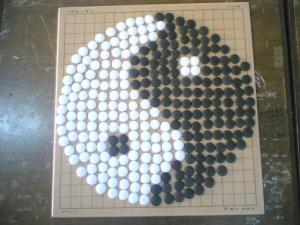 |
| Eight Dragons- eight different cursive representations of the character 龍 (dragon), from Compilation of Cursive Characters (《草字彙》), authored by Shi Liang (石梁) of the Qing Dynasty. The artists are: 1 Sun Guoting; 2, 3 Huai Su; 4 Yan Zhenqing; 5 Zhao Mengfu; 6, 7 Zhu Zhishan; 8 anonymous. |
If you want to learn Chinese Calligraphy, you’d better learn
about the development of Chinese characters. Chinese characters, beginning with jiaguwen or Oracle Bone Script, used in Shang Dynasty (about the 16th –11th century B.C.), have a long
history of around 3000 years. Generally, we think jiaguwen is the oldest Character
because it is the earliest, mature and systematic Chinese writing system we have found, thus far. In its long history, Chinese writing evolved continuously. The scripts of Chinese characters are jiaguwen, jinwen, xiaozhuan, lishu, caoshu, xingshu,
kaishu and so on. Kaishu and xingshu are used often, now.
I have not modified or corrected the English for the following paragraphs.
甲骨文
Jiaguwen
This kind of Chinese character is the one discovered from
the remains of shang Dynasty. Because these Characters were carved or written
on the tortoise shells and the bones, it was called jiaguwen. It is the oldest
Chinese character, we found. The square turning is the main way of writing (or
carving), and smooth turning is rare. Its lines are thin mostly.
金文
Jinwen
Jinwen is the one mainly used in shang Dynasty,and Zhou
Danasty and sometimes in Han Dynasty. It was discovered on the bronze wares, so
it was named jinwen. These verses cast on the ancient zhongs(bells) and dings
(the ancient Chinese cooking vessels with two loop handles and three or four
legs) were almost the ones to put down the contributions of the kings and their
officials in those times, so this kind of script has another two names,
zhongdingwen and mingwen( the script of inscriptions). The style of jinwen is
the same as jiaguwen, but neater and more well-balanced, and its lines are
thicker, too.
小篆
 |
| Qinshihuang |
Xiaozhuan
When Chinese history came to Qin Dynasty, Qinshihuang made China a union.
He launched the first reform of Chinese character. The character used by Qin
kingdom was sorted out and simplified and used in the united country, and the
other (six) kingdoms’ characters were banished. This reformed character was
named xiaozhuan or Qinzhuan which was originated from the former characters,
but its lines are the neatest and most well-balanced, and the shapes of it are
even firmer. It is very important, for it is the end of the ancient Chinese
characters (jiaguwen, jinwen, xiaozhuan) and the beginning of the modern
Chinese characters (lishuu, caoshu, xingshu, kaish).
隶书
Lishu
Lishu was developed from xiaozhuan in Qin Dynasty, and
mainly used in Han Dynasty and Wei Dynasty. Compared with xiaozhuan, the
strokes of lishu are straighter and squarer, and it removes the feature of
picture of Chinese character. Since then, the shades of Chinese characters have
almost been stabilized. Of course, there are some differences in different
scripts.
草书
Caoshu
Caoshu is from lishu in Han Dynasty, and grown up in Jin
Dynasty. It is the fast writing form of lishu, called zhangcao first. Its
developed type is called jincao (modern caoshu).
楷书
Kaishu
It is also known as Zhengshu Script, and evolved from seal
characters. It is simpler in structure and square in shape. To be specific, it
is more standardized horizontally and vertically. The integral feature of
formal script is neatness and orderliness, for which reason it is widely used
and favored today.
行书
Xingshu
Xingshu and kaishu are also developed from lishu in Han
Dynasty and are popular in Wei Dynasty, Jin Dynasty and South-north Dynasty.
They are very practical, and used widely till today.





